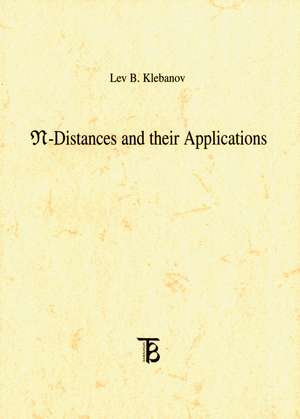N-distances and Their Applications
Autor Lev B. Klebanoven Limba Engleză Paperback – 31 mar 2006
The book focuses on probability metrics suitable for the characterization of random variables in Hilbert or Banach space. It provides details of various stochastic processes, such as testing non-deterministic statistical hypotheses, characterization of probability distribution or constructing multidimensional test for two selections. The book is published in the English language.
Preț: 75.15 lei
Preț vechi: 89.32 lei
-16% Nou
Puncte Express: 113
Preț estimativ în valută:
14.38€ • 14.84$ • 12.00£
14.38€ • 14.84$ • 12.00£
Carte indisponibilă temporar
Doresc să fiu notificat când acest titlu va fi disponibil:
Se trimite...
Preluare comenzi: 021 569.72.76
Specificații
ISBN-13: 9788024611525
ISBN-10: 802461152X
Pagini: 96
Dimensiuni: 203 x 305 x 5 mm
Greutate: 0.25 kg
Editura: Karolinum Press, Charles University
Colecția Karolinum Press, Charles University
ISBN-10: 802461152X
Pagini: 96
Dimensiuni: 203 x 305 x 5 mm
Greutate: 0.25 kg
Editura: Karolinum Press, Charles University
Colecția Karolinum Press, Charles University
Cuprins
Preface
Chapter 1. Positive and Negative Definite Kernels and Their Properties
1. Definitions of positive and negative definite kernels
2. Examples of positive definite kernels
3. Positive definite functions
4. Negative definite kernels
5. Coarse embeddings of metric spaces into Hilbert space
6. Strictly and strongly positive and negative definite kernels
Chapter 2. N-Metrics in the Set of Probability Measures
1. A class of positive definite kernels in the set of probabilities and N-distances
Chapter 3. m-negative Definite Kernels and Metrics
Chapter 4. N-metrics and the Problem of Recovering Measures From Potential
1. Recovering Measures From Potential
2. Stability in the Problem of Recovering a Measure from Potential
Chapter 5. N-metrics in the Study of Certain Problems of Characterization of Distributions
1. Some characterization of Gaussian and related distributions
2. Characterization of distributions symmetric to a group of transformations
Chapter 6. Commutative Semigroups with Positive Definite Kernel
1. General considerations
2. Distances in X
3. Special representations
4. Properties of x(t)
5. Infinitely divisible elements
6. Accompanying infinitely divisible elements
7. Examples
Chapter 7. Statistical Estimates obtained by the Minimal Distances Method
1. Estimating a location parameter, I
2. Estimating a location parameter, II
3. Estimating a general parameter
4. Estimating a location parameter, III
5. Semiparametric estimation
Chapter 8. Some Statistical Tests Based on N-Distances
1. Multivariate two-sample test
2. Test for two distributions to belong to the same additive type
3. Some Tests for Observations to be Gaussian
4. A Test for Closeness of Probability Distributions
Chapter 9. A Permutation Test Motivated by Microarray Data Analysis 1. Introduction
2. Theoretical framework: the test statistic
3. Computational framework: accuracy of permutation quantiles and p-values
4. Power of the test: a simulation study
5. Examples of data analysis
6. Conclusions of the Chapter
Bibliography
Author Index
Index
Chapter 1. Positive and Negative Definite Kernels and Their Properties
1. Definitions of positive and negative definite kernels
2. Examples of positive definite kernels
3. Positive definite functions
4. Negative definite kernels
5. Coarse embeddings of metric spaces into Hilbert space
6. Strictly and strongly positive and negative definite kernels
Chapter 2. N-Metrics in the Set of Probability Measures
1. A class of positive definite kernels in the set of probabilities and N-distances
Chapter 3. m-negative Definite Kernels and Metrics
Chapter 4. N-metrics and the Problem of Recovering Measures From Potential
1. Recovering Measures From Potential
2. Stability in the Problem of Recovering a Measure from Potential
Chapter 5. N-metrics in the Study of Certain Problems of Characterization of Distributions
1. Some characterization of Gaussian and related distributions
2. Characterization of distributions symmetric to a group of transformations
Chapter 6. Commutative Semigroups with Positive Definite Kernel
1. General considerations
2. Distances in X
3. Special representations
4. Properties of x(t)
5. Infinitely divisible elements
6. Accompanying infinitely divisible elements
7. Examples
Chapter 7. Statistical Estimates obtained by the Minimal Distances Method
1. Estimating a location parameter, I
2. Estimating a location parameter, II
3. Estimating a general parameter
4. Estimating a location parameter, III
5. Semiparametric estimation
Chapter 8. Some Statistical Tests Based on N-Distances
1. Multivariate two-sample test
2. Test for two distributions to belong to the same additive type
3. Some Tests for Observations to be Gaussian
4. A Test for Closeness of Probability Distributions
Chapter 9. A Permutation Test Motivated by Microarray Data Analysis 1. Introduction
2. Theoretical framework: the test statistic
3. Computational framework: accuracy of permutation quantiles and p-values
4. Power of the test: a simulation study
5. Examples of data analysis
6. Conclusions of the Chapter
Bibliography
Author Index
Index
